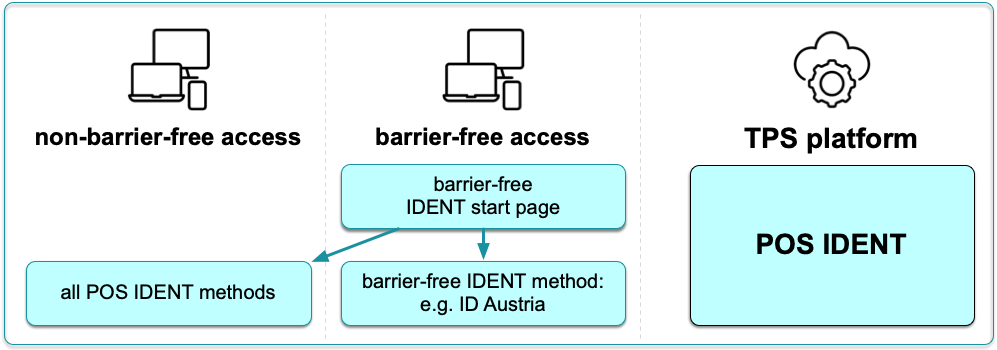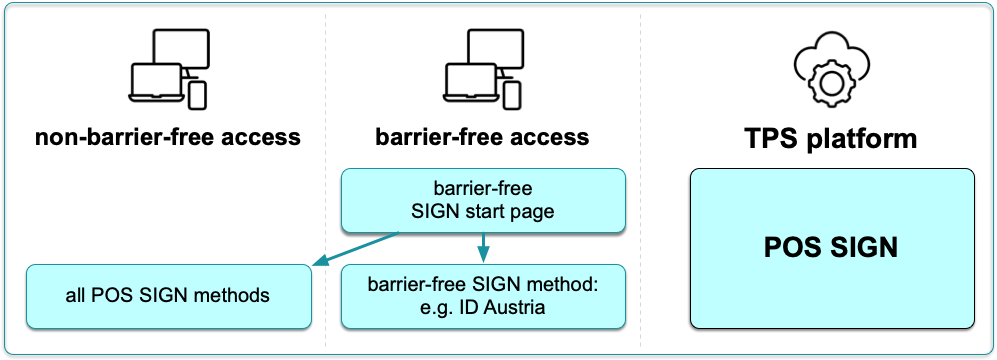Accessibility
Declaration on the accessibility of Trusted Platform Services (TPS) provided by POS Solutions GmbH: What our users need to know.
POS Solutions GmbH strives to make its products and services accessible in accordance with the Federal Act on Accessibility of Websites and Mobile Applications of the Federal Government (Web Accessibility Act – WZG) BGBl. I. No. 59/2019 as amended.
This accessibility statement applies to the services and products of POS Solutions GmbH.
Status of implementation of requirements
The services of the TPS platform are partially compliant with the AA level of the “Web Content Accessibility Guidelines – WCAG 2.2” or with the applicable European Standard EN 301 549 V3.2.1 (2021-03) in accordance with Directive (EU) 2016/2102 of the European Parliament and of the Council.
Continuous improvement work with regard to accessibility is an integral part of the development process.
Non-accessible content
The TPS contain areas of application that are not yet fully accessible. However, POS Solutions strives to make the functionalities themselves accessible or, if this is not possible, to offer an alternative functionality that is as accessible as possible.
Incompatibility with accessibility regulations
The following products and services are partially or not yet fully accessible:
- POS FOTOIDENT (in all versions)
- POS BANKIDENT
- POS SIGN (in all versions)
The following content does not fall within the scope of the applicable legal provisions
Third-party content (such as ID Austria) that is not within the sphere of influence of POS Solutions GmbH is excluded from the WZG. No statement can be made regarding the compatibility of this third-party content with accessibility regulations.
Furthermore, the respective customer-specific CI specifications (and thus accessibility agendas in terms of contrast, font size, font type, etc.) are not within the sphere of influence of POS.
Not all TPS are suitable for ensuring accessibility
Many of our customers in the retail, mobile communications, banking, and insurance sectors, among others, who already offer digital customer onboarding, are currently investing in new fully automated technologies such as online identification and electronic signatures. It should be noted that some identification and signature methods are more suitable than others in terms of their support for accessibility. POS Solutions is committed to offering every user remote identification and signature methods that are appropriate to their abilities and capabilities in accordance with existing regulations. With its modular design, the TPS platform offers the possibility of creating a service offering tailored to the user and thus also providing the appropriate methods for achieving accessibility. This is an important step toward a better customer experience.
How do we implement accessibility within the Trusted Platform Services (TPS)?
TPS is a service platform based on a modular design principle. The individual services, functions, and products are standardized and can be used to implement online onboarding processes and combined as required for the specific application. This also applies to the implementation of accessibility.
The platform's services span three modules in the areas of data collection, online authentication, and electronic signatures. When implementing accessibility, the three modules POS DATAHUB, POS IDENT, and POS SIGN must be considered individually, as accessibility is implemented differently in each module.
The following figure provides a graphical overview of the TPS modules and the associated processes.

POS DATAHUB is a data hub for structured data collection, distribution, and interface queries. DATAHUB offers an HTML-based front end for integrating and implementing BPM and DMS.
How is accessibility ensured in POS DATAHUB?
1. Since POS DATAHUB is equipped with an HTML-based front end, the AA compliance level of the “Web Content Accessibility Guidelines – WCAG 2.1” or the applicable European standard EN 301 549 V3.2.1 (2021-03) in accordance with Directive (EU) 2016/2102 of the European Parliament and of the Council.
2. Older POS DATAHUB routes that cannot be converted in a timely manner due to release cycles, interfaces, etc., and for which the directive cannot therefore be implemented natively, will receive a plugin that can convert the DATAHUB route to the directive with the help of a wizard.
The diagram above shows the process described above.

POS IDENT enables standardized and secure online remote identification using a variety of methods.
How is accessibility guaranteed at POS IDENT?
Since not all identification methods offer this option, accessibility is guaranteed by always providing at least one alternative accessible identification method.
We have decided to offer the official ID Austria identification method, which is promoted by the Austrian Federal Chancellery, as the standard accessible identification method. This could be supplemented with accessible alternatives such as FILIALIDENT or VIDEOIDENT, for example.
Nothing will change for our customers. Even existing implementations can be expanded if necessary without changing the existing process: Customers' users can choose between accessible and non-accessible methods via the accessible POS IDENT start page. The processes are explained in detail on the IDENT start page.
The diagram above shows the process described above.

POS SIGN is used for legally compliant electronic signing of contracts, receipts, forms, etc. POS SIGN generates advanced and qualified electronic signatures in accordance with the European eIDAS signature directive.
How is accessibility guaranteed with POS SIGN?
Not all electronic signature methods offer accessibility. Here too, accessibility is guaranteed in the same way as for identification methods, by ensuring that at least one alternative accessible electronic signature method is always available.
Here, too, we have decided to offer the official ID Austria identification method promoted by the Austrian Federal Chancellery as the standard accessible electronic signature method. This could be supplemented with accessible alternatives such as TAN signatures or signatures at the point of sale.
Nothing will change for our customers. Even existing implementations can be expanded if necessary without changing the existing process: Customers' users can choose between accessible and non-accessible methods via the accessible POS SIGN start page. The processes are explained in detail on the SIGN start page.
The diagram above shows the process described above.
Preparation of the accessibility statement
This statement was prepared on June 11, 2025, and was last updated on the same date. The statement was prepared on the basis of a self-assessment conducted in accordance with WCAG 2.1 at conformity level AA.
Feedback and contact details
The offers and services on POS Services and Products are continuously improved, replaced, and expanded. Usability and accessibility are very important to us.
If you notice any barriers that prevent you from using our website—problems that are not described in this statement, deficiencies in compliance with accessibility requirements—please let us know by email. We will review and process your request.
Please send your comments and suggestions to barrierefrei@pos.ag with the subject line “Report a barrier.” Please describe the problem and, if possible, include screenshots of the affected areas.
Enforcement procedure
If you are not satisfied with the response provided by the above contact option, you can lodge a complaint with the complaints office of the Austrian Research Promotion Agency (FFG). The FFG accepts complaints electronically via the contact form of the complaints office.
The FFG will examine the complaints to determine whether they relate to violations of the provisions of the Web Accessibility Act, in particular deficiencies in compliance with accessibility requirements, by the federal government or an institution attributable to it.
If the complaint is justified, the FFG must issue recommendations for action to the federal government or the legal entities concerned and propose measures to remedy the deficiencies.
